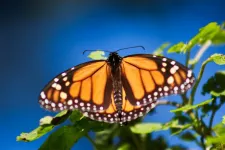(Press-News.org) New research published in Anaesthesia (a journal of the Association of Anaesthetists) shows the huge pressure that anaesthesia and critical care staff in the UK have been under throughout the winter wave of COVID-19, as the number of newly admitted infected patients surged and most planned surgeries, including a substantial number of critical cancer operations, were cancelled.
"These findings have important implications for understanding what has happened during the COVID-19 pandemic, planning recovery and building a system that will better respond to future waves or new epidemics," explains co-author Professor Tim Cook, Consultant in Anaesthesia and Intensive Care Medicine, Royal United Hospitals Bath NHS Foundation Trust, Bath, UK, and Honorary Professor, School of Medicine, University of Bristol, UK.
Between October 2020 and January 2021, the authors conducted three national surveys to track anaesthetic, surgical and critical care activity during the second COVID-19 pandemic wave in the UK - the first round as the November 2020 lockdown was being implemented, the second in December 2020 as restrictions were lifted, and the final survey in February 2021 just after the peak of the new year surge caused by the new Kent (UK) variant of SARS-CoV-2.
They surveyed all NHS hospitals where surgery is undertaken. Response rates, by round, were 64%, 56% and 51%. The surveys showed increasing systemic pressure on anaesthetic and peri-operative services due to the need to support critical care pandemic demands.
There was evidence of significant stress in the system in October and this increased in December 2020 including redeployment of one in six doctors from anaesthesia to critical care, and by December approximately half of critical care units were expanded so much that planned surgery could not be safely undertaken. During this period, almost one in five operating theatres were closed but many hospitals were able to displace surgery to other locations. Overall surgery rates fell by around one quarter compared with similar periods in previous years.
The situation then deteriorated dramatically during the peak of the second surge (January 2021), with responses showing that the system was close to breaking point. Almost half of all operating theatres were closed and those that were open were often running at close to half normal activity. Hospitals were less able to relocate activity to other locations, due to lack of staff.
"The impact on surgery was in part due to a lack of space in which to operate as operating theatres were used as expanded ICUs. But the most important factor was lack of anaesthetists to deliver care as they were redeployed to critical care. In the January peak, almost one in three anaesthetic doctors were unavailable for anaesthetic work as redeployments more than doubled the critical care workforce," explains Prof Cook. "All but a quarter of critical care units were expanded to the extent that planned surgery could not be safely undertaken. As a result, surgical activity fell massively, with all types of surgery affected. There was important regional variation and in hard-pressed regions, paediatric and non-cancer surgery fell to 12-20% of normal activity and even cancer surgery, usually considered an urgent priority, fell to below half of normal activity."
As long as the UK's exit from lockdown restrictions continues and vaccination rates keep COVID-19 infections low, a rapid decompression is likely to occur whereby critical care units quickly decrease their capacity and the rest of the health system resumes elective and other surgical care. However, tackling the surgical backlog requires working at well above normal capacity for several years and even returning to normality is likely to be challenging. Co-author Dr Emira Kursumovic says: "Our data illustrate very clearly that anaesthetists - and in all probability other healthcare providers working in operating theatres - have been central in the critical care response to the pandemic, and that they will have been similarly impacted. These staff have had an increased workload and intensity, decreased leave, and psychological burdens including moral injury. The physical and psychological needs of the workforce must be considered in planning recovery of non-COVID healthcare services."
The authors add: "The surveys illustrate the pressure points in the current system. These include space and, most particularly, staff. The fact that critical care expansion requires redeployment of substantial numbers of anaesthetists is likely to have important implications for at least the next year, as critical care services work flexibly to address fluctuations in demand and expand as necessary. This in turn will have important implications for addressing surgical waiting lists. Expansion of both space and the anaesthetic workforce are likely to be inevitable requirements."
Dr Mike Nathanson, President of the Association of Anaesthetists, said: "These important surveys demonstrate the pressure anaesthetists and anaesthetic departments were under during the pandemic surges. The impact on the mental and physical wellbeing of our colleagues is still being felt. The impact on the health of the nation, in terms of the expanding waiting lists for investigations and surgery, is a huge concern. Workforce shortages and the inability for many of our trainee anaesthetists to progress their careers due to the lack of suitable jobs will accentuate this backlog, even without any further surges."
Professor Ravi Mahajan, President of the Royal College of Anaesthetists, which funded the surveys, said: "These findings confirm the central role anaesthetists played during the pandemic, treating critically ill patients with and without COVID. It is clear that the success of any recovery will hinge on having the right staff, in the right place, at the right time."
He adds: "In the rush to reduce the backlog, however, we must not forget the enormous physical and psychological toll that working in the pandemic has had on anaesthetists. Any attempt to go too fast risks staff cutting back on hours or leaving the profession altogether, jeopardising the sustainability of the NHS. It is vital that we take onboard the lessons from the past year, so we are able to identify areas for improvement, plan a sustainable NHS recovery and respond more effectively to future pandemics."
INFORMATION:
A general practitioner, wife and mother has recounted her experience with COVID-19 which saw her stay in hospital 150 days and become one of the first patients to be treated with extracorporeal membrane oxygenation (ECMO), special equipment that completely takes over the function of the lungs and is a last resort option.
The self-written case report, which appears in the journal Anaesthesia Reports (a journal of the Association of Anaesthetists) is by Dr Anushua Gupta, who works as a general practitioner in Stockport, Greater Manchester, UK. It is thought to be the first patient-written account of ECMO to treat COVID-19 to appear in the medical literature.
Extracorporeal membrane oxygenation was introduced as ...
Simon Fraser University researchers are playing a key role in guiding conservation efforts to protect a declining butterfly population. The eastern monarch butterfly, an important pollinating species known for its distinct yellow-orange and black colour, is diminishing due to the loss of the milkweed plant--its primary food source.
Researchers analyzed current conservation strategies and recommended changes to how and where declining milkweed can be restored, based on assessments of climate and butterfly migration. Their study is published today in Frontiers in Environmental ...
As the global energy demand continues to grow along with atmospheric levels of carbon dioxide (CO2), there has been a major push to adopt more sustainable and more carbon-neutral energy sources. Solar/wind power and CO2 capture - the process of capturing waste CO2 so it is not introduced into the atmosphere - are two promising pathways for decarbonization, but both have significant drawbacks.
Solar and wind power is intermittent and cannot be deployed everywhere; CO2 capture processes are incredibly energy-intensive. Both of these pathways have benefits, but each ...
PROVIDENCE, R.I. [Brown University] -- Mindfulness-based meditation programs have emerged as a promising treatment for conditions ranging from stress to sleeplessness to depression. In some cases, they're even offered to people -- schoolkids or employees, for example -- who aren't actively seeking help or who haven't been screened for suitability. Yet most research and discourse about these programs focuses only on their benefits, with little investigation of the risks or the potential for adverse effects.
A recent review of nearly 7,000 studies of meditation practices found that less than 1% of them measured adverse effects. Willoughby Britton, an associate professor of psychiatry and human behavior at Brown University, said that this is largely because ...
New research from BYU published in PLOS Medicine found that providing medical patients with social support leads to an increased chance of survival and elongation of life. Such findings come at a critical time as doctors and healthcare professionals seek new ways to improve care and decrease mortality.
"The premise of the research is that everyone is strongly influenced by their social context," said BYU counseling psychology professor Timothy B. Smith, lead author of the study. "Relationships influence our behavior and our physical health. We now know that it is possible to prolong ...
ITHACA, N.Y. - Wines and table grapes exist thanks to a genetic exchange so rare that it's only happened twice in nature in the last 6 million years. And since the domestication of the grapevine 8,000 years ago, breeding has continued to be a gamble.
When today's growers cultivate new varieties - trying to produce better-tasting and more disease-resistant grapes - it takes two to four years for breeders to learn whether they have the genetic ingredients for the perfect flower.
Females set fruit, but produce sterile pollen. Males have stamens for pollen, but lack fruit. The perfect flower, however, carries both sex genes and can self-pollinate. These hermaphroditic varieties generally yield bigger and better-tasting berry ...
Due to climate change, the average global temperature will rise in the coming decades. This should also significantly increase the number of so-called cooling degree days. These measure the number of hours, in which the ambient temperature is above a certain threshold, at which a building must be cooled to keep the indoor temperature at a comfortable level. The rising values may lead to an increased installation of AC systems in households. This could lead to a higher energy demand for cooling buildings, which is already expected to increase due to climate change and population growth.
Nip-and-tuck ...
Scientists have long thought that there was a direct connection between the rise in atmospheric oxygen, which started with the Great Oxygenation Event 2.5 billion years ago, and the rise of large, complex multicellular organisms.
That theory, the "Oxygen Control Hypothesis," suggests that the size of these early multicellular organisms was limited by the depth to which oxygen could diffuse into their bodies. The hypothesis makes a simple prediction that has been highly influential within both evolutionary biology and geosciences: Greater atmospheric oxygen should always increase the size to which multicellular organisms can grow. ...
When a person views a familiar image, even having seen it just once before for a few seconds, something unique happens in the human brain.
Until recently, neuroscientists believed that vigorous activity in a visual part of the brain called the inferotemporal (IT) cortex meant the person was looking at something novel, like the face of a stranger or a never-before-seen painting. Less IT cortex activity, on the other hand, indicated familiarity.
But something about that theory, called repetition suppression, didn't hold up for University of Pennsylvania neuroscientist Nicole Rust. "Different images produce different amounts of activation even when they are all novel," says ...
The combination of a carb-heavy diet and poor oral hygiene can leave children with early childhood caries (ECC), a severe form of dental decay that can have a lasting impact on their oral and overall health.
A few years ago, scientists from Penn's School of Dental Medicine found that the dental plaque that gives rise to ECC is composed of both a bacterial species, Streptococcus mutans, and a fungus, Candida albicans. The two form a sticky symbiosis, known scientifically as a biofilm, that becomes extremely virulent and difficult to displace from the tooth surface.
Now, a new study from the group offers a strategy for disrupting this biofilm by targeting the yeast-bacterial interactions ...



